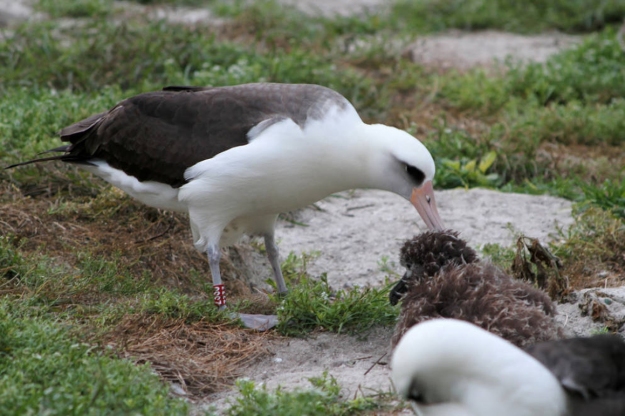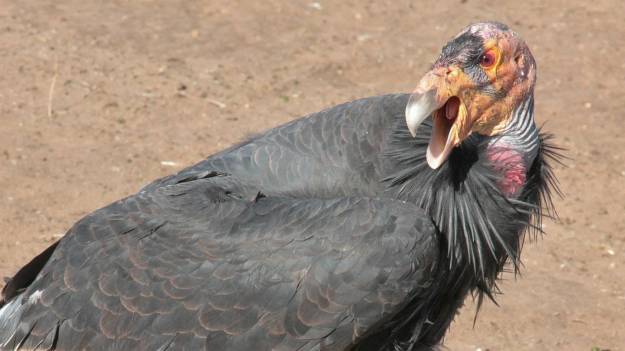Readers with good memory will recall that I’ve written numerous times over the years about a special bird by the name of Wisdom.
She’s making headlines again!
Wisdom, the world’s oldest known wild bird, recently returned to Midway Atoll. She was first spotted back in this familiar territory on Nov. 24, 2022, in fact.
Wisdom is considered world’s oldest wild bird
The beloved Laysan albatross is at least 71 years old now. Biologists first identified and banded Wisdom in 1956 after she laid an egg, and these large seabirds aren’t known to breed before age five.

Photo by Bob Peyton/USFWS • Midway Atoll National Wildlife Refuge and Battle of Midway National Memorialwithin Papahānaumokuākea Marine National Monument is a special place for over three million seabirds – they return to Midway Atoll each year to rest, mate, lay eggs and raise their chicks.
Researchers have estimated that Wisdom has produced 50 to 60 eggs and as many as 30 chicks that fledged, according to Jonathan Plissner, supervisory wildlife biologist at Midway Atoll National Wildlife Refuge.
The ageless Wisdom, with her well-known band number of Z333, was first spotted this nesting season on Thanksgiving Day. Her long-time mate, Akeakamai, has yet to be seen and was absent last nesting season, too. Male albatrosses typically return to the breeding site before their mates, wrote Plissner in an email.
For decades, Wisdom and Akeakamai, like most pairs of these albatrosses, returned every year to the same nest site to lay one egg.
They are among the millions of albatross that return to Midway Atoll on the far northern end of the Hawaiian archipelago to nest and raise their young.
For some unknown reason, Wisdom only made a brief appearance late last year. In a release dated Dec. 9, 2022, the U.S. Fish and Wildlife Service noted that Wisdom had not been seen in the past week and most mōlī have already laid their egg for the season, but biologists will continue to monitor the area in case the world’s oldest known bird returns.
Among albatross, the Laysan albatross is a small species. This bird has a body length of 23 inches and a wingspan of about 80 inches, or six-and-a-half feet. The larger species of albatross have wingspans of 12 feet.
Worldwide, there are about 20 or so species of albatross. Most albatrosses range in the Southern Hemisphere from Antarctica to Australia, South Africa, and South America.
In literature, the poem “The Rime of the Ancient Mariner” by Samuel Taylor Coleridge uses an albatross to explore the concepts of innocence and creation.
French poet Charles Baudelaire also featured this bird in his poem titled “L’Albatros.”
Albatrosses haven’t coexisted easily with humans. Fifteen of the world’s albatross species face possible extinction. Two species, Tristan albatross and waved albatross are considered critically endangered.
Albatrosses are long-lived birds, with some gaining a ripe old age of 50 years or more. Only parrots rival them for longevity, with some parrots and macaws documents as living more than a century.
Wisdom hatched her most recent chick in February 2021, making her at least 70 years old at the time. She is the oldest confirmed wild bird and the oldest banded bird in the world.
I hope that Wisdom’s simply off gliding over the world’s vast oceans and will make more future appearances. Since learning of her story, I’ve been continually amazed by her indomitable spirit. Long may she fly.
Speaking of long lives among out feathered friends, there are some impressive age milestones that have been reached by other birds.
Longevity Records
According to the American Bird Conservancy website, here are some of the world’s longest-lived wild birds:
• common raven — 69 years
• American flamingo — 49 years
• bald eagle — 38 years
• sandhill crane — 37 years
• Canada goose — 33 years
• Atlantic puffin — 33 years
• red-tailed hawk — 30 years
• mourning dove — 30
• great horned owl — 28 years
• mallard — 27 years
• blue jay — 26 years
• great blue heron — 24 years
• laughing gull — 22 years
• piping plover — 17 years
While it’s usually the larger birds that live longer, some songbirds, just like people, can live astonishingly long lives. The hummingbirds, which are truly tiny, can produce individuals that reach a relatively old age. For instance, a broad-billed hummingbird has been documented reaching the age of 14 years.
•••
Email me at ahoodedwarbler@aol.com to share sightings or ask questions.










